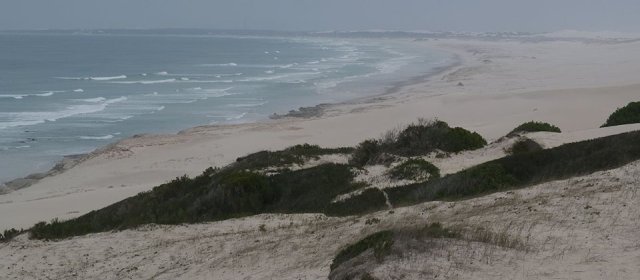Marginal conditions in the De Hoop Reserve

Author: Ivan Lätti
Photographer: Martin Etsebeth
An exposed dune is a hard place for a pioneer plant to colonise, seen from a human perspective. Unrelenting sun, wind and temperatures do, however, also test the mettle of participating plant species adapted to face this challenge. Plants growing in places like this De Hoop Nature Reserve dune may be seen visibly struggling at the tipping point of life and death; small, haggard and restricted to limited areas surrounded by bare sand.
Low soil fertility and high salt content take their toll, as do winds that erode, exposing roots and drying everything further than the natural low moisture retention of the sandy soil. Build-ups of sand bury plants partly or totally. All these hazards leave their marks on plants, on all living species and affect their mortality.
Yet life as a collective force, as the strongest warrior of all, is not affected by its casualties. Nature tests all accessible limits relentlessly. It deposits something alive close to every manageable extreme and every borderline of existence, for life is extensive as well as intensive.
Once the heroic pioneer species has stabilised the terrain, claiming it on behalf of plants of the world without a word or thought, things get a little easier. By adding humus to the soil from plant bodies of many past generations, the way is cleared for the slightly less tough types to join. They help tame the spot a little further until collective, gradual victories turn bare patches green, oblivious of the time-frame.
Some species don’t make it for too long but leave something as transition contributors, adding to the rich history sometimes traceable in science. Over time, suitable kinds of new plants arrive to dominate, given the conditions of their era. All or some of them may be locally shaped and honed to meet new requirements and procreate. Thus life adopts new shapes and processes, each stage and form a springboard for further adventures of becoming. It all may even assume meaning, or rather meanings, if there are people around to invent them.
Strong in certain dimensions, fragile and delicate in others, ecologies are vulnerable, be they sparsely covered coastal dunes or imposing tropical forests. Human intervention can destroy vegetation, has become destroyer-in-chief on earth. A niche landscape may be lost in one human visit that took countless generations of plants to establish, giving their all.

